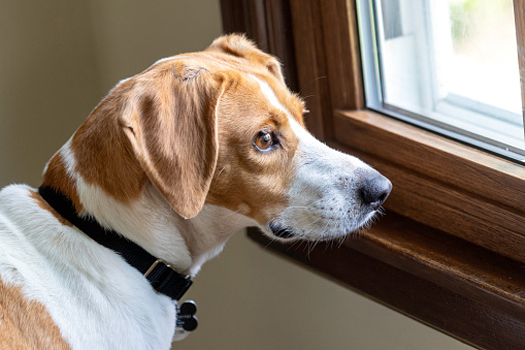Our Services
Dog Anxiety
We can assist in identifying the root causes of problems like separation anxiety and compulsive behaviour in order to create a productive, compassionate training regimen.

Pet Dog Anxiety
Just like humans, dogs experience anxiety. Dog anxiety can affect all breeds, but may affect each individual dog differently.
Some of the more common types of anxiety:
- Separation Anxiety
- Noise Phobias
- Isolation Anxiety
- Social Anxiety
- Confinement Anxiety
Dogs can exhibit anxiety through a wide range of behavior problems, including:
-
- Destructive Behaviors
- Drooling
- Ears Pulled Down or Back
- Excessive Barking
- Licking Lips
- Panting
- Shaking
- Whining
- Whites of the eyes showing
Separation Anxiety
Separation anxiety is estimated to now affect around 76% of dogs, that is a lot more than the pre-pandemic estimated 14% of dogs. Dogs with separation anxiety are unable to find comfort when they are separated from their family members. This anxiety often manifests itself in undesirable behaviors, such as going to the bathroom in the house, destroying furniture and property damage, and excessive barking.
The goal in treating separation anxiety in dogs is to encourage your dog’s ability to relax when you are away from home. Helping a dog get past separation anxiety takes time and patience—unfortunately, there’s no such thing as a quick fix for stress-based behaviors
Exercise Your Dog
Most dogs can benefit from increased exercise, from a walk prior to your departure, to playing challenging games that stimulate their minds prior to being left alone. Finding treats that are hidden in a puzzle toy or working on something like “spin” or “high five” can help your dog get ready to settle once you leave for the day. The mental stimulation will leave your dog ready for a rest.
Give Your Dog Interactive Toys
Dogs can also learn to enjoy the ritual of getting a treat-stuffed goody when their person leaves the house for the day. There are also many interactive toys on the market to encourage your dog to stay mentally stimulated while you’re away.
Anxiety Medications for Dogs
Your veterinarian may recommend anxiety medication to assist by decreasing their overall anxiety, enabling training to be more successful.
Noise Phobia
Noise phobia is an excessive fear of a sound that results in the dog attempting to avoid or escape from the sound. It’s an intense and persistent fear response that can develop at any age and in any dog breed. Your dog’s response to noise is like a person having a panic attack but with different symptoms.
The most common causes of noise phobia are fireworks and thunderstorms, what many may not realize is that every day noises inside and outside of the home can have the same effect. Routine tasks like vacuuming, mowing the lawn, sounds of the doorbell ringing, the garbage truck on the street can have your pet trying to escape from the noise. A dog’s normal instinctive behavior is to seek shelter to avoid danger but things can go awry when dogs overreact to sounds that don’t represent danger and instead of hiding in the bathroom, they take off running outside of the home. The Pets I Love emphases on microchipping in the scary event your beloved pet runs off into the night during 4th of July fireworks.
We offer a simple, safe, and effective solution to noise aversion. SILEO is a medicine
prescribed by your veterinarian. It helps calm your dog when frightened by loud noises around your home without making them drowsy. Given as needed—When your dog hears a scary noise, SILEO is easy to give and works fast to calm them down. No daily medication needed
Think Your Dog May Have Noise Aversion?
See where they rank on the Scare Scale.
https://www.zoetispetcare.com/quiz/noise-aversion
If your dog is spooked by sound, share the results with your veterinarian and ask them if SILEO can help.
Isolation Anxiety
Isolation Anxiety is different from Separation Anxiety, although they can present similarly. Isolation Anxiety only arises when a dog is completely alone with no other companions. Dogs with isolation anxiety will not exhibit any symptoms as long as they’re in the company of a human.
Dogs live in the moment. Dogs are not being destructive on purpose. Anxious behavior will usually display within ten minutes of being alone.
• Destructive Behaviors
• Whining, Whimpering, Barking, or Other Vocalizations.
• Using the Bathroom in the House When Otherwise House-Broken.
• Excessive Salivating, Drooling and/or Panting
• Pacing
• Shaking or Trembling
• Crating Difficulties: Difficulty with or Refusal to be Crated or Confined
• Escape Attempts: Chewing Through Crates, Doorways, or Walls
Isolation Anxiety can range from mild to severe, and what works for one dog may not work for another with a more extreme case.
• Try to stick to a schedule as often as possible.
• Crate train your dog while you’re home before confining them for long periods while you’re away.
• Practice short periods of separation from your pets when you’re at home.
• Turn on the radio or TV while you’re away.
• Install security cameras.
• Do not use physical or verbal punishment.
• Seek help from your veterinarian.
Your veterinarian may be able to prescribe anti-anxiety medication to help control your dog’s symptoms and make them more comfortable in your absence.
Social Anxiety
Dogs with social anxiety may feel comfortable and relaxed at home with their family members. However, they may experience intense fear when encountering new people, animals, and unfamiliar environments, including the sights and sounds within that new place. This anxiety can be mild or severe, depending on the individual dog.
We’ve all felt the stress and nervousness that comes with meeting new people, speaking in public, or being in new places with large crowds. It’s a common experience that most of us can relate to. However, we often forget that our pets, particularly our dogs, can experience similar fears and anxieties.
- Fearful Behavior: Cowering, Hiding Behind Their Owner, Shaking, Whining, or Yelping
- Nervous Behavior: Panting, Drooling, and Sudden Urination
- Aggressive Behavior: Barking, Growling, Lunging or Nipping at Other People
It’s important to recognize these behaviors in your dog and take steps to address their anxiety. Here are some tips to help your dog feel more comfortable in stressful situations:
- Gradual Exposure: Slowly introduce your dog to the situation that causes anxiety, giving them time to adjust and build confidence.
- Positive Reinforcement: Reward your dog with treats, praise, and affection when they display calm behavior in stressful situations.
- Exercise: Regular exercise can help reduce your dog’s overall anxiety levels.
- Medication: In some cases, medication may be necessary to help manage your dog’s anxiety.
The Pets I Love offers personalized guidance and support to help your dog overcome their anxiety.
Confinement Anxiety
Confinement anxiety in dogs refers to the panic and stress they experience when confined to a crate or small space. When dogs suffer from this type of anxiety, their brains process things differently, and being confined can worsen their stress levels. It’s similar to being stuck in a packed elevator, which can make even non-anxious individuals nervous or uncomfortable.
The reasons for a dog’s crate panic can vary and may not always be related to separation anxiety. For example, dogs rescued from shelters may have negative associations with small wire kennels from being confined for long periods. Thus, even smaller crates may not provide comfort.
Moreover, dogs with confinement anxiety may cause more damage or hurt themselves while in their enclosure or crate, such as shredding bedding, bending crate wires, or causing self-injury.
Here are some additional tips to help you with crate training your dog:
1. Make the crate as comfortable and inviting as possible. Use soft blankets and toys to create a cozy environment.
2. Start by leaving the crate door open and allowing your dog to explore it on their own.
3. Once your dog is comfortable with the crate, try luring them inside with treats or toys.
4. Gradually increase the amount of time your dog spends in the crate, starting with just a few minutes at a time.
5.Never use the crate as a form of punishment, as this will only make your dog associate it with negative experiences.
6. Be patient and consistent with your training, and always reward your dog for good behavior.
The Pets I Love offers personalized guidance and support to help your dog overcome their anxiety.
If you’re concerned that your dog might have an issue with anxiety, it’s best to consult with your veterinarian — your veterinarian can diagnose your dog, rule out any other health issues, and help you develop a treatment plan that best fits your dog and lifestyle.
